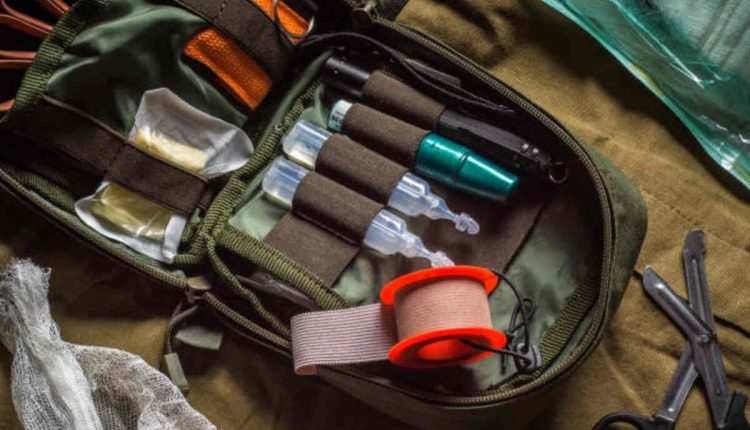An emergency first aid kit should be readily accessible at home, work, and in your vehicle. This ITS Tactical kit contains essential medical supplies with a heat-sealed storage case to avoid contaminants contaminating supplies over time. bugout bag
Put together your first-aid kit or purchase one from a reliable retailer. Take into account your location, potential emergencies you might face, and level of training when planning.
1. Bandages
Bandages are essential components of any first aid kit, serving to control bleeding and support healing in injured areas. They typically look like tightly rolled white cotton tubes packaged in sterile plastic.
Cohesive bandages adhere to themselves rather than hair or skin, making application simple and quick. You can also use them as makeshift slings to support broken arms or legs; roller and triangular bandages can be folded differently for specific injuries.
2. Alcohol Prep Pads
Alcohol prep pads are essential components of any first aid kit, as they disinfect skin wounds and reduce infection risks in minor wounds. These sterile pads typically contain 70% isopropyl alcohol for efficient antiseptic action and feature two layers.
They can also be helpful in cleansing cuts before applying other applications, such as an ointment or bandage, without stinging and are easy to use.
These first aid supplies are great to have around the house or keep in a survival first aid kit – get yours today!
3. Swabs
An emergency first aid plan that includes swabs and medical supplies is an invaluable asset, assisting in blood clotting, wound cleansing, and treating bacterial infections.
Though having the necessary survival first aid supplies is essential, knowing how to utilize them properly is equally crucial. We suggest attending a first aid training course so you’re prepared in case of medical emergencies – some kits even include safety whistles, paracord cords, and survival blankets!
4. Gloves
Gloves protect hands and forearms against cuts, abrasions, puncture wounds, chemical contact with hazardous substances, and some electrical shocks. In addition, gloves may help prevent contamination either to victims or responders during medical interventions.
Latex gloves provide comfort and excellent sensitivity; however, some individuals may develop an allergic reaction. Vinyl and powder-free nitrile gloves offer safer alternatives.
An effective temporary fix for an open chest wound is to tape plastic over three sides, leaving one open so as to allow ventilation. Unfortunately, this approach could obstruct lung function.
5. Antibiotic Ointment
Antibiotic ointment is designed to prevent infection and aid healing in minor cuts, scrapes, and abrasions by applying directly to any wound that might become infected. These over-the-counter medicines typically include bacitracin, neomycin, and polymyxin B sulfate for maximum effectiveness.
Antibiotic ointment differs from antiseptic wipes in that it kills bacteria instead of simply cleansing an area and also provides moistness that facilitates wound healing.
These items provide the essential link between injury and advanced medical treatment, ensuring wounds heal with no complications and healing can begin quickly and efficiently.
6. Antiseptic Wipes
Antiseptic wipes are excellent ways of disinfecting cuts or wounds and helping reduce colonization with harmful bacteria, speeding healing time. Furthermore, antiseptic wipes are great for sterilizing the skin prior to using catheters or other medical equipment.
Hospitals and first aid kits rely on antiseptic wipes containing Benzalkonium Chloride to kill germs, making them perfect for cleaning hands, sanitizing surfaces, or acting as an alternative to soap and water. Available both individually packaged as well as larger boxes.
7. Cold Pack
When someone has a bruise or muscle strain, cold therapy is often beneficial in relieving their discomfort and swelling. You can make your cold compress using frozen vegetables in bags, icy towels, or other sources.
Be Smart Get Prepared’s value option kit offers supplies you won’t find in larger kits, including splints. Additionally, its durable hard case is easily opened one-handed for quick and organized storage of supplies – perfect for car camping and backcountry adventures alike! Further, Dr. Sokolow recommends this choice as ideal for families with active children in sports programs.
8. Burn Gel
Burn gel can be an essential resource in situations with limited access to resources, such as remote or austere settings. Furthermore, it offers an alternative means of cooling a burn with running water when this option may not be practical or safe (such as during mass casualty situations).
Burn gel dressings provide relief to burnt skin without trapping heat energy, drying quickly without leaving behind a sticky residue or painkiller–they’re an invaluable addition to any first aid kit that meets the new 2015 ANSI requirements.
9. Bug Wipes
Bug wipes can be an indispensable addition to a survival first aid kit, providing reliable protection from biting insects like mosquitoes and ticks that carry diseases like Zika, Dengue, or West Nile, with individual wrapper DEET repellent towels offering reliable coverage.
Your survival first aid kit should contain butterfly closure strips to seal wounds, tweezers for extracting stingers and splinters, scissors, as well as personal locator beacons (PLBs) that transmit emergency signals that allow rescuers to locate survivors in remote areas.
10. First Aid Guide
First aid kits provide essential supplies to treat minor injuries in both your home and car, including supplies needed to perform CPR. Knowing how to use your items effectively could save lives; consider enrolling in a CPR class for more excellent knowledge.
Survival first aid kits contain medical supplies designed to aid individuals during most emergencies until professional assistance arrives. Such kits typically include basic supplies like a thermometer, scissors, and medical grade gloves as well as medications like Tylenol (acetaminophen) and Ibuprofen (ibuprofen), antiseptic wipes and first aid guides – the latter two being particularly essential items in such kits.

